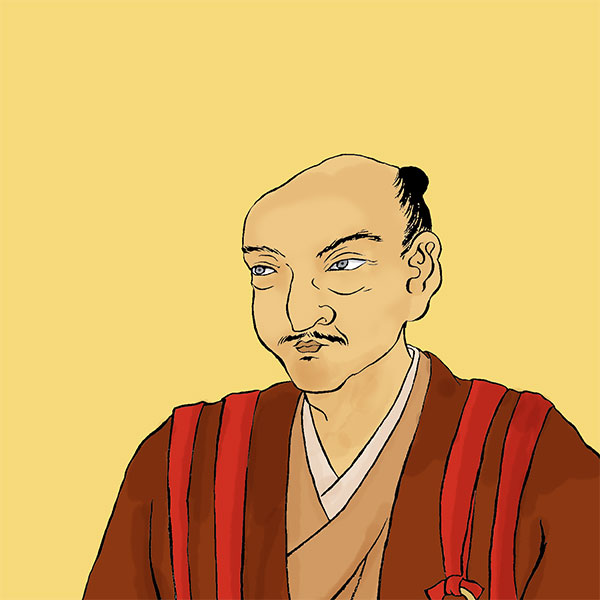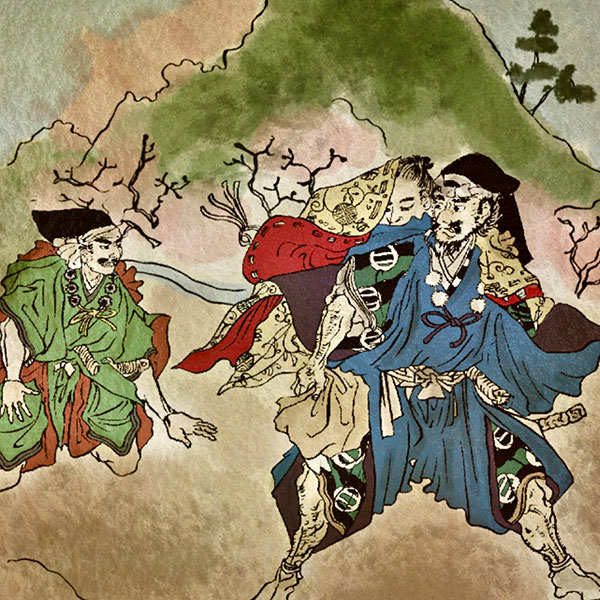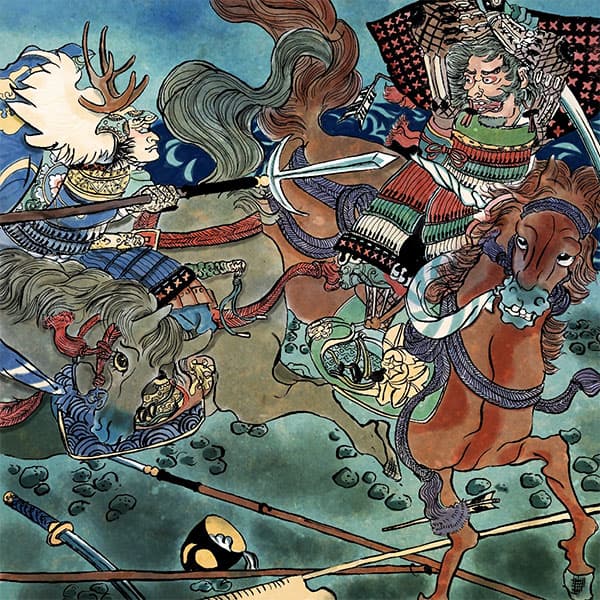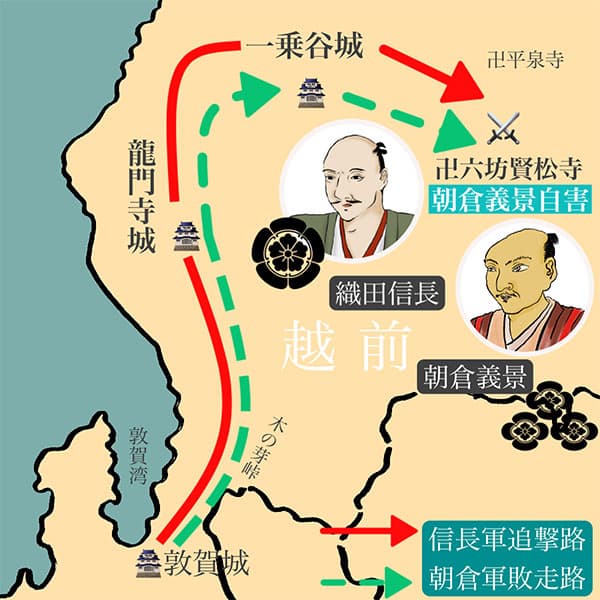Yoshikage Asakura (1/2)Nobleman of Echizen

Yoshikage Asakura
- Article category
- biography
- name
- Yoshikage Asakura (1533-1573)
- place of birth
- Fukui prefecture
- Related castles, temples and shrines

Ichijodani Asakura Residence
- related incident
During the period commonly known as the Sengoku period, there was a feudal lord known as the Asakura clan who rose to prominence in Echizen Province, Hokuriku (present-day Reinan, Fukui Prefecture). The last head of the Asakura family was Yoshikage Asakura. When Yoshikage became the head of the Asakura family, he made his presence known by protecting and supporting the wandering Yoshiaki Ashikaga. However, with the appearance of Oda Nobunaga, the gears of fate were thrown out of whack and they were forced into a corner. This time, we will look at Asakura Yoshikage, who was forced into ruin due to his conflict with Nobunaga.
Echizen Asakura family
The Asakura clan produced Yoshikage Asakura.
The Asakura clan was founded by Munetaka Kusakabe at the end of the Heian period. Munetaka took the surname Asakura because he lived in Asakura, Yabu District, Tajima Province, and the Tajima Asakura clan began.
The era passed the Kamakura period and entered the Nanbokucho period. Hirokage Asakura, the head of the Tajima Asakura clan during the Nanbokucho period, served the Shiba clan, a member of the Ashikaga clan. Hirokage's son, Asakura Takage, served Takatsune Shiba and was given territory in Echizen Province. However, Takatsune Shiba was forced out of his position as Echizen governor during the Sadaharu Incident, and Takakage Asakura left the Shiba family and defected to the shogunate. The Asakura family then settled in Echizen Province and expanded their influence. This is where the Echizen Asakura clan began, splitting from the Tajima Asakura clan.
However, the Shiba family returned to Echizen Shugo. The Asakura family returned to the Shiba family, the guardians of Echizen, but they could not ignore the Asakura family, which was expanding their influence, and the Shiba family, along with the Kai clan and the Oda clan (the first of the Oda clan, which later produced Nobunaga Oda), moved to Echizen. He was appointed as the guardian of the country.
In the late Muromachi period, Asakura Takakage (Eibayashi Takakage), along with the Shugodai Tsuneharu Kai, came into conflict with the Shiba family. He took most of Echizen Province into his hands and effectively became the lord of Echizen Province. Takakage established the ``Asakura Toshikage 17 Articles'', which was a law to divide the country. From here, the Asakura family became the Sengoku daimyo Asakura family.
Since Echizen Province was unified from an early stage during the Sengoku period, troops were dispatched to neighboring countries Wakasa Province (present-day Reinan, Fukui Prefecture), Kaga Province (Ishikawa Prefecture), Omi Province (northern Shiga Prefecture), and Mino Province (Gifu Prefecture). I visited the surrounding area.
The Echizen Asakura family became a Sengoku daimyo during Takakage's time, and was succeeded by Ujikage, Sadakage, Takakage, and their children. Asakura Yoshikage was born as Takakage's child.
Birth of Yoshikage and inheritance of family headship
Yoshikage Asakura was born in September 1533 as the eldest son of Takakage Asakura, the 10th head of the Echizen Asakura family. His childhood name was Nagayasha. It is said that his mother was a daughter of the Takeda family, the shugo of Wakasa Province.
In 1548, when Yoshikage was 16 years old, he took over as the head of the family after his father, Takakage, passed away. In September, he will travel to Kyoto to give a speech on his behalf. He built a relationship with Kyoto, including the daughter of Harumoto Hosokawa, Kanrei of the Muromachi Shogunate, as his legal wife.
In June 1552, the 13th Shogun of the Muromachi Shogunate, Yoshiteru Ashikaga (Yoshiteru Ashikaga at the time), gave him the character ``Yoshi'' and changed his first name from ``Enkei'' to ``Yoshikage''. On the other hand, Yoshikage builds a relationship with Yoshiteru by presenting him with a Sutaka in a garden basket. Furthermore, he was appointed Saemon no kō. Even the successive heads of the Asakura family had never been given such a high position. It is believed that the Asakura family had the daughter of a Kanrei as their legal wife, and that the weak shogun Yoshiteru Ashikaga had high expectations for the Asakura family and gave them preferential treatment.
In this way, Yoshikage, who became the head of the Asakura family at a young age, made his presence felt through diplomacy and expanded his influence. The background to this was largely due to the existence of Soteki Asakura, a senior military officer in charge of political and military affairs.
Yoshikage and Soteki
Sengoku daimyo Asakura family. In the middle of the Muromachi period, Asakura Takakage effectively occupied Echizen Province and became a feudal lord during the Sengoku period. This eighth son of Takakage was the future Asakura Soteki. In other words, he was the younger brother of Ujikage Asakura, Yoshikage Asakura's great-grandfather (his grandfather's father). Soteki showed talent in the military and politics, and was active as the elder brother of the four Asakura family heads, from his older brother Ujikage to Sadakage, Takakage, and Yoshikage.
Soteki was born in Bunmei 9 (1477). This was the year when the Onin War that occurred in Kyoto ended. In 1503, Asakura Kagetoyo, the lord of Tsuruga Castle in Echizen Province, betrayed the Asakura head family. Sotetsu, who was married to Kagetoyo's sister who had betrayed him, was asked to help, but he tipped off the head of the family, Sadakage Asakura (his brother's son), and his betrayal was exposed. Kagetoyo Asakura was ordered to commit suicide, and Tsuruga Castle was given to Soteki, who began to rise to prominence. The military affairs of the Asakura family were left to Soteki, who sent troops to the Honganji Ikko Ikki in Kaga Province (present-day Ishikawa Prefecture), north of Echizen Province, Wakasa Province (present-day Reinan, Fukui Prefecture), and even Omi Province in the south. In 1528, he intervened in the internal conflict (Ryohosokawa Rebellion) of the Kanrei Hosokawa family in Kyoto, making his name even famous in the central area.
Soteki, who protected the Echizen Asakura family from foreign enemies and even intervened in conflicts in other countries, is seen as the de facto head of the Asakura family.
Sotetsu Asakura not only showed military and political talent, but also artificially bred hawks by hatching them from eggs in his garden, enjoyed the tea ceremony, which was seen as cutting-edge culture at the time, and at one point produced the masterpiece ``Nine-haired Nasu.'' He showed a variety of talents such as possessing. In this way, Sotetsu created the Sengoku Asakura family in one generation. Even after Yoshikage Asakura became the head of the family, he continued to look after him, but he passed away at the age of 79 in September 1555. However, the 22-year-old Toshinkei would later become acutely aware of the loss of Soteki, a giant star of the Sengoku period.
Yoshikage and Yoshiaki Ashikaga
After Asakura Sotetsu's death in 1555, Asakura Yoshikage took charge of government affairs himself. From here, it fought with Wakasa Province in the south and Kaga Province, which was effectively ruled by the Ikko Ikki in the north.
Now, 10 years have passed since Yoshikage took charge of political affairs himself. In 1565, Yoshiteru Ashikaga was murdered by the Miyoshi family in Kyoto (Eiroku Incident). By the way, Yoshiteru Ashikaga had a younger brother, Kakukei, who later became Yoshiaki Ashikaga. Kakukei worked as a monk at Kofukuji Temple in Nara, but when his older brother Yoshiteru was murdered, he was imprisoned by the Miyoshi family.
It is said that Yoshikage Asakura helped Kakukei escape from Kofuku-ji Temple by communicating with Yoshiteru's vassals, such as Hosokawa Fujitaka and Wada Koremasa. This is mentioned in a letter between Yoshiteru and Yoshiaki's uncle Yoshitoshi Daikakuji and Uesugi Kenshin, the shugo daimyo of Echigo Province.
After escaping from Kofukuji Temple in Nara, Kakukei returned from being a monk to a samurai at the Yajima Imperial Palace in Omi. Yoshiaki Ashikaga initially tried to rely on the Takeda family, the shugo daimyo of Wakasa Province, but later turned to Yoshikage Asakura. In November 1565, Ashikaga Yoshiaki settled down at Anyoji Temple in Ichijodani and received a congratulatory greeting from Asakura Yoshikage.
Yoshiaki Ashikaga, who visited Echizen Province, requested Yoshikage Asakura to support him and go to Kyoto. He also sent letters to other feudal lords urging them to come to Kyoto, and Yoshiaki's imperial letter was accompanied by a subletter from Yoshikage Asakura. At this point, Yoshikage Asakura assumed a position essentially equivalent to Kanrei.
However, in 1568, Yoshikage Asakura's eldest son Akimimaru suddenly died, and Yoshikage lost his desire to go to Kyoto. Disappointed by this, Yoshiaki Ashikaga approached Nobunaga Oda, who had given up on the Asakura family and captured Mino Province. Yoshikage Asakura tried to stop Yoshiaki, but Yoshiaki left Echizen with a letter of gratitude for his kindness during his stay.
Battle of Anegawa
In August 1568, an internal conflict broke out in neighboring Wakasa Province. Yoshikage Asakura kidnapped Motoaki Takeda, the shugo daimyo of Wakasa Province, in the name of protection and placed him under house arrest in Ichijodani. Katsuhisa Awaya, a vassal of the Takeda family, and the Kumagai clan resisted the Asakura family, but the Asakura family was able to temporarily control Wakasa Province.
- related incident

- WriterTomoyo Hazuki(Writer)I have loved history and geography since my student days, and have enjoyed visiting historical sites, temples and shrines, and researching ancient documents. He is especially strong in medieval Japanese history and European history in world history, and has read a wide range of things, including primary sources and historical entertainment novels. There are so many favorite military commanders and castles that I can't name them, but I especially like Hisashi Matsunaga and Mitsuhide Akechi, and when it comes to castles, I like Hikone Castle and Fushimi Castle. Once you start talking about the lives of warlords and the history of castles, there's a side of you that can't stop talking about them.






